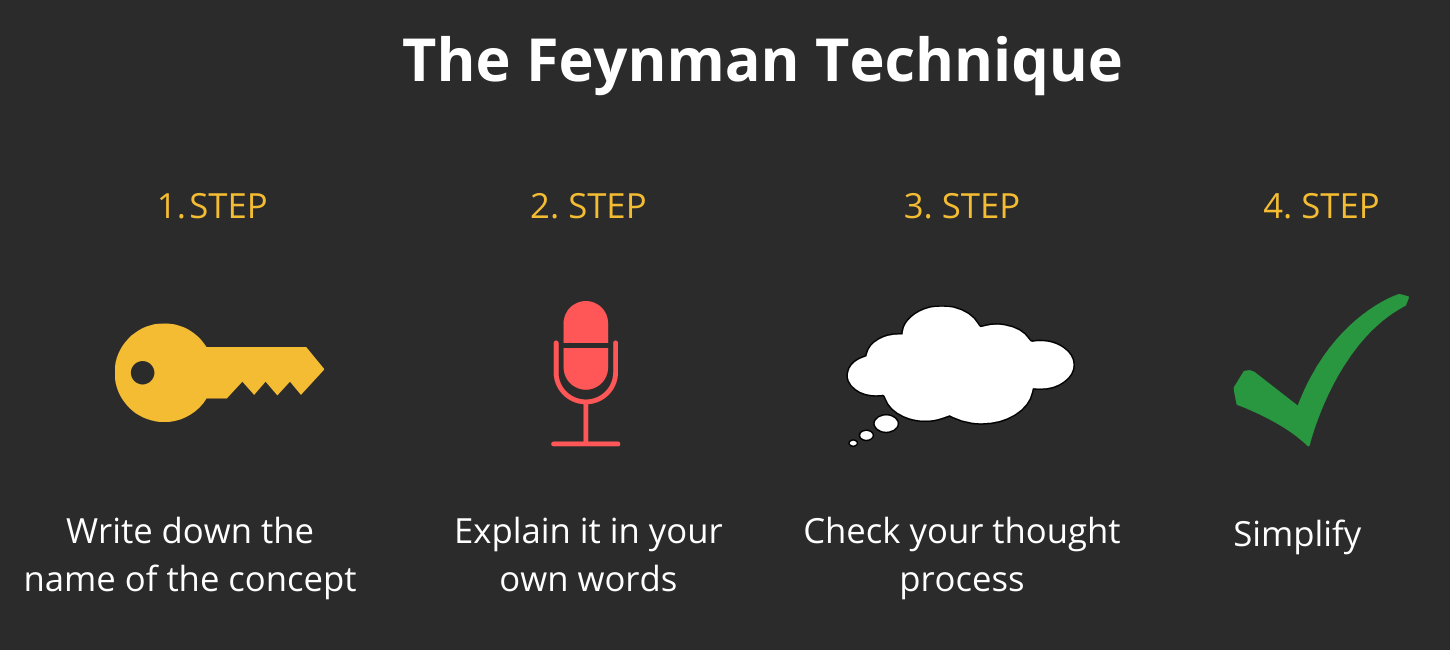Learning something new and getting it to stick can be difficult🧠.
You can re-read the same line over and over again, rewatch part of a lecture at 0.5x speed, but the next day you've already forgotten the information🤦🏼♀️. Surely there must be a better way!
One proven method is The Feynman Technique.
The Feynman Technique is named after American theoretical physicist and Nobel Prize winner Richard Feynman, who often employed the method throughout his career.
The Feynman Technique consists of 4 steps. Take a look at this graphic and keep reading for further explanation⬇️

Let's examine each of these steps a little closer🔬.
- Identify the concept you want to learn or are in the process of learning. This can be information for an upcoming exam, a presentation for work, a new sport, even an article on tips for improving how you study and learn😜.
- Teach what you know about the concept to someone else. The general recommendation is to teach it to someone as if they were a sixth grader👦🏾. By simplifying how you teach the information, it forces you to deeply analyze the topic and create smaller, more easily understood points. The Feynman Technique is most effective when using a real person (who can provide real-time feedback) but teaching to an imaginary audience or writing the information out is certainly useful as well📝.
- Identify and fill in gaps in your knowledge. Were there certain areas that you had difficulty explaining, or could not speak to at all? Now is the time to go back to the source material or use new resources to fill in these blank spaces🪣. Using different types of media (textbook, recorded lecture, written notes, podcast) can be a powerful method for accomplishing this.
- Simplify the content and make connections. Some sources consider this step to be optional but in my opinion, it is absolutely necessary. Just like in step 2, simplifying the content encourages you to remove excess, lower yield information and also helps to create connections between information that you already knew and information you've just learned🔗.
"If you can't explain it to a six year old, you don't understand it yourself" Albert Einstein
Overall, The Feynman Technique is a straightforward yet effective way to learn anything💡.
If you're a medical student reading this however, you may be wondering how applicable The Feynman Technique truly is🤷🏼. After all, it can be difficult breaking down and explaining the complex biochemical pathways and physiologic processes taught in medical school and in other advanced areas.
While it is important to note that The Feynman Technique should not be used in isolation and may not be the best fit for certain types of learners, cycling through the four steps multiple times can work to distill and reinforce information through repetition and summarization💧.
Speaking from personal experience, this was a technique I frequently used in medical school to run through things like the different characteristics of pathogens in Microbiology🧫 and various disease processes in Pathology🩻.
Next time you're trying to learn something new, give The Feynman Technique a try and see if you notice a difference in how much you remember!
💙 Something I love: The PAPERAGE Lined Notebook is my go-to for taking notes and writing out concepts. It has a high quality look and feel but remains minimalist and portable. I've already gone through a few of these and have no plans on stopping!
📨 Subscribe to Sunday Morning Rounds: Sign up for my monthly newsletter and receive tips and resources to help you learn, grow, and become a better doctor.
📱 Social media: Find me at @MedSchoolMoose on Instagram, TikTok, and YouTube to enjoy more of my content!